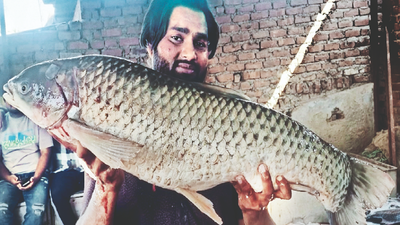- News
- City News
- chandigarh News
- Native carps displacing exotics
Trending
This story is from March 16, 2023
Native carps displacing exotics
In the first two nights of the big-sized and old fish-thinning and stock-taking operation at Sukhna Lake, 106.6 quintals were netted, of which the largest specimen was an exotic Grass carp of 16 kg, length 27 inches and an estimated age of 6-7 years. The specimens were identified by Panjab University’s zoology department and the preliminary assessment was that native carps released last in November 2019 had exceeded expectations in growth and were replacing the dominant exotic (foreign) carps.

The monster Grass carp of 16 kg netted from Sukhna Lake in Chandigarh
In the earlier fish-removal exercise conducted in October 2015 over three nights, the largest specimen netted was just 6.7 kg.The current operation is scheduled for 10 nights till March 22. “The specimens identified by the zoology team include the species of Rohu, Mrigal, Catla, Common carp and Silver carp. There were also specimens which displayed hybridisation between Catla and Rohu. Since breeding of these fish is generally between the ages of 1-3 years, it was important to remove them to restore ecological balance of the Sukhna as these netted fish were of big sizes and turning unproductive from the breeding point of view. Their domination of the lake’s waters has a severely negative impact on small-medium fish preferred by migratory and other resident birds such as kingfishers, herons etc,” joint director, animal husbandry and fisheries, Dr Kanwarjit Singh, told TOI.
The zoology department’s team leader, Dr Ravneet Kaur, detailed the negative impacts of big fish after an on-the-spot inspection of the netted specimens in the early hours of Monday and Tuesday. The zoology team also took some netted specimens for laboratory analysis as a part of their ongoing project titled, ‘To investigate the genomic diversity and morphometric characteristics of carps from natural and artificial water bodies of Chandigarh’.
“The big fish simply outcompete the smaller fish for food. The same impact is felt by the smaller, Benthic (bottom-dwelling) invertebrates, such as burrowing bivalves, crayfish, tubificid worms and aquatic insect larvae. These invertebrates are a food source for wetland bird species but when big fish are overabundant and dominate the lake, the availability of invertebrates is reduced. Big fish have a negative impact on the development of a particular species of algae. So, keeping in mind these factors, the administration should conduct a fish-removal exercise every 2-3 years,” Dr Kaur told TOI.
Once the operation is completed, the fisheries department will release seed of the native carps into the lake. The department had released 3,500 seed in November 2019, 3,000 seed in November 2018 and 5,000 seed in July 2016. Since the lake does not have a natural outlet, the big carps keep growing and exercise domination. A sudden release of flood water, as was the case during the monsoons last year, led to high fish mortality as they got entangled in the regulator gates and also perished downstream. As the dry summer approaches, a drought or very low water levels also leads to high fish mortality.
End of Article
FOLLOW US ON SOCIAL MEDIA










